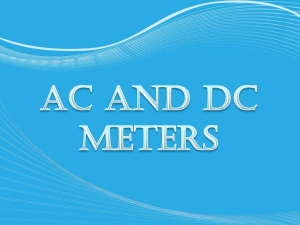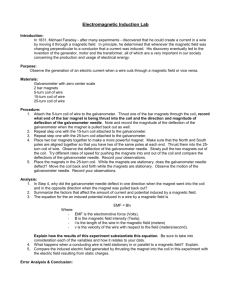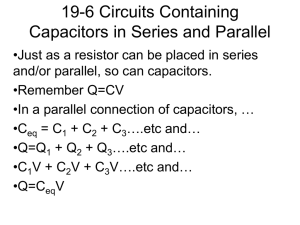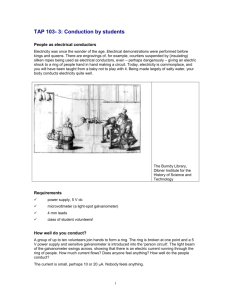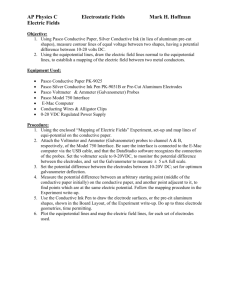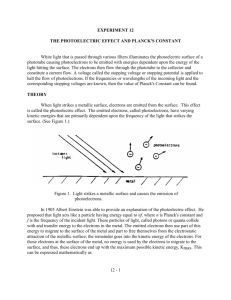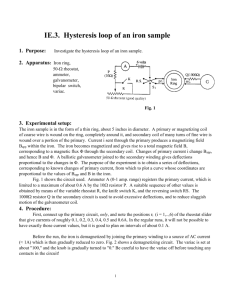Full Experiment: The Ballistic Galvanometer and Damped Oscillations
advertisement
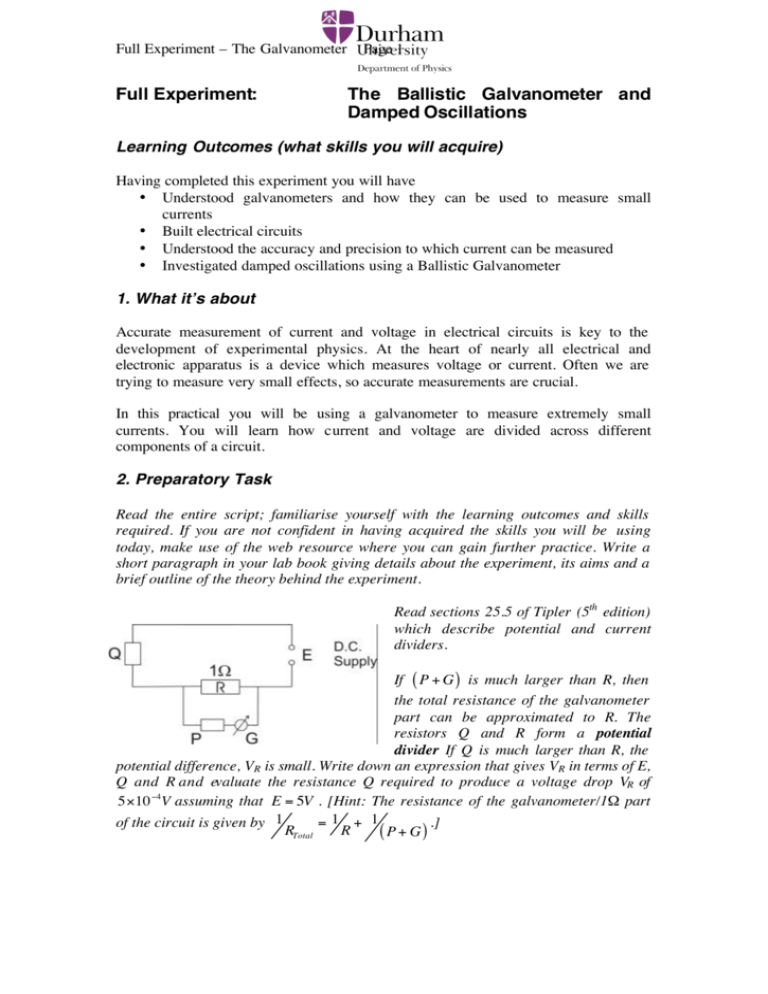
Full Experiment – The Galvanometer Full Experiment: Page 1 The Ballistic Galvanometer and Damped Oscillations Learning Outcomes (what skills you will acquire) Having completed this experiment you will have • Understood galvanometers and how they can be used to measure small currents • Built electrical circuits • Understood the accuracy and precision to which current can be measured • Investigated damped oscillations using a Ballistic Galvanometer 1. What it’s about Accurate measurement of current and voltage in electrical circuits is key to the development of experimental physics. At the heart of nearly all electrical and electronic apparatus is a device which measures voltage or current. Often we are trying to measure very small effects, so accurate measurements are crucial. In this practical you will be using a galvanometer to measure extremely small currents. You will learn how current and voltage are divided across different components of a circuit. 2. Preparatory Task Read the entire script; familiarise yourself with the learning outcomes and skills required. If you are not confident in having acquired the skills you will be using today, make use of the web resource where you can gain further practice. Write a short paragraph in your lab book giving details about the experiment, its aims and a brief outline of the theory behind the experiment. Read sections 25.5 of Tipler (5th edition) which describe potential and current dividers. If ( P + G ) is much larger than R, then the total resistance of the galvanometer part can be approximated to R. The resistors Q and R form a potential divider If Q is much larger than R, the potential difference, VR is small. Write down an expression that gives VR in terms of E, Q and R and evaluate the resistance Q required to produce a voltage drop VR of 5 ×10 −4V assuming that E = 5V . [Hint: The resistance of the galvanometer/1Ω part of the circuit is given by 1 =1 + 1 .] RTotal R ( P + G) Full Experiment – The Galvanometer Page 2 The resistance R and the combination of P and G in parallel with R act as a current divider, limiting the current flowing through the galvanomet er. By explicitly writing Ohm’s law for each leg of the current divider, and using you expression for the voltage, VR that you found above, show that the current flowing through the combination of P and G is given by: I ( P+ G ) = VR ER = ( P + G ) ( R + Q )( P + G ) (1) [1 Mark] 2.1 Experimental Preparation The Galvanometer If you look closely at an analogue ammeter or voltmeter you will see that there the deflection of the arm to give the reading is controlled through a magnetic coil. A galvanometer consists of a coil of wire would around a plastic former. This is suspended between the poles of a magnet. When current is passed to the galvanometer coil, it produces a magnetic field which interacts with the field produced by the permanent magnet. This torque, causes the coil to rotate, and a pointer fixed to the coil to move. The galvanometer you will be using has a mirror attached to the coil, light is reflected from the mirror onto the scale on the front of the machine. Identify the d.c. power supply E, the hand-held multimeter and the 1Ω resistor, R, on the desk in front of you. Identify the resistance boxes (labelled P, Q and S in the script). By turning the dials on the resistance boxes, the resistance can be varied from a few ohms up-to several thousand ohms. Task 1: Quickly check each of the resistance boxes – P, Q and S. What is the reported accuracy of the resistance boxes? Measure the resistance of the boxes with the dials set at 4 different values using the hand held multimeter. Do your measurements agree, within error, with what the dials say? Make sure that you check that there are no systematic errors over the entire range of the resistance boxes. What is the error on the readings for the different scales? [1 Mark] Full Experiment – The Galvanometer Page 3 3. Ready to Start In this experiment you will use the galvanometer as a voltmeter. The resistance of the galvanometer is governed by the metallic coil. Typical values of resistance of metallic coils are in the range of 1 to 1000Ω. This range is controlled by the composition and amount of the coil material. Therefore, in order to use a galvanometer as a sensitive voltmeter we will need to add a large resistance in series with it. Recall from skills session 1 that the resistance of a voltmeter should be very high. YOU SHOULD HAVE REACHED THIS STAGE WITHIN 20mins One of the principal reasons for using a galvanometer is their sensitivity to very small currents. We will therefore need to limit the voltage that will be dropped across the galvanometer, and hence the current that flows through it. To achieve this we construct potential and current dividers. The galvanometer with the resistance box P in series with it act as a voltmeter, measuring the voltage drop across the 1Ω resistor, VR. The current that flows through the galvanometer part of the circuit is supplied by this potential difference. VR is made small by dropping the source voltage E (approx 5V) across the potential divider Q and R, with Q much larger than R. The current flowing through the combination of P and G will induce a torque on the galvanometer coil which in turn will deflect the light beam a distance d, the magnitude of d being proportional to the current flow: d ∝ I so we can write that d = kI (2) What are the SI units of k? In what units should you record the deflection? The constant of proportionality k is defined as the current sensitivity, and so from equation (1) we can say that: E R d =k (3) ( P + G ) (R + Q ) Full Experiment – The Galvanometer Page 4 In this experimental configuration, setting P=1,000Ω and Q=10,000Ω should produce a current flow of approximately 5 × 10−7 A through the galvanometer which will produce a torque displacing the beam on the galvanometer by a couple of centimetres. 4. Measurements: Finding the Internal Resistance of the Galvanometer Equation (3) can be re-arranged into the following forms: RE k = P +G R +Q d OR P= RE k −G R +Q d (4) The values of k and G can be found by varying P and recording the displacement of the galvanometer beam. Task 4: Set the power supply to give 5V. Record its value and uncertainty in your lab book. Construct the circuit below using the components you have already identified. Initially set P = 1000Ω and Q = 10,000Ω . This should cause the beam to move by a couple of centimetres. Reduce P and increase Q to keep the deflection on the scale. Continue until P is zero and then adjust Q to give an almost full scale deflection. Then keep Q fixed and make a note of its value and uncertainty in your lab book. Now make a series of measurements of the deflection d as P is increased. From equation (4), a plot of P against 1 d will give a straight line with an intercept of G. However, as it is P that we are varying (the dependent variable), this should be β P G plotted on the x axis. The straight line graph you should plot is = + (c.f. d k k RE y = mx + c ) where β = . Calculate β and its error, and use a spreadsheet to R+ Q generate the data in a form that will be suitable for plotting. Full Experiment – The Galvanometer Page 5 [Hint: The % errors on R, E, Q are all approximately 1%. The error on R+Q is the same as that of Q alone. Thus, we can approximate the error on β as being 3% ] Use Excel and Linest to find the slope and intercept of your graph. Make sure you only use data for which the error bars are not too large in your least squares calculation. Use these values to determine the current sensitivity k and the value of G. What are the uncertainties in these measurements? [2 Marks] Carefully look at the back of the galvanometer, and you will see a summary of its properties when it was tested some years ago. Do your values for the resistance and current sensitivity agree, within error, with the quoted values? YOU SHOULD HAVE REACHED THIS STAGE WITHIN 1½ HOURS The Torsion Pendulum and the Ballistic Galvanometer Consider a disk suspended from a torsion wire attached to its centre. This setup is known as a torsion pendulum. A torsion wire is essentially inextensible, but is free to twist about its axis. Of course, as the wire twists it also causes the disk attached to it to rotate in the horizontal plane. Any twisting of the wire is inevitably associated with mechanical deformation of the wire which is resisted by developing a restoring torque which acts to restore the wire to its untwisted state. For small angles of twist, the magnitude of this torque is directly proportional to the twist angle – hence we have simple harmonic motion. The ballistic galvanometer is a galvanometer adapted to measure charge as opposed to current. It measures the charge flowing through the system during the passage of a transient current and is based on the ideas behind the torsion pendulum. If the period of oscillation is long in comparison with the transient current; the electromagnetic pulse created in the coil acts as the impulse to start the coil oscillating. The angular displacement, θ is directly related to the charge, Q. The galvanometer you are using has been selected because the coil has a high moment of inertia which results in a long oscillation period. However, because of effects of air-resistance and other ‘resistive’ effects within the coil, these oscillations will be damped, and the coil will eventually come to rest at the equilibrium point. Full Experiment – The Galvanometer Page 6 Measuring the Period of Oscillations Rebuild your circuit so that the following is realised: This time the potential divider P and S provides a voltage to charge a standard capacitor, C. This capacitor can be discharged into the galvanometer using the Morse key. The amount of charge, Q, discharged is simply given by Q = VC with the voltage dropped across the capacitor, V, given by the potential divider P and S. Thus we have that the charge is given by: P Q = EC (5) (P + S) This instantaneous current (charge pulse) provides the impulse to set the galvanometer into oscillations. The coil begins to swing, but because of damping it will not reach its maximum deflection a0 . Instead it is deflected to a1 on the first swing, a2 on the second and so on at the following times: t =T4 d = a1 3T 4 a2 5T 4 a3 (6) The amplitude of the swings is being damped by an exponential which, as a function of time, t, has the following form: A = exp ( −γ t ) (7) with γ the damping term. It follows then that the ratio of successive amplitudes is related to the period of oscillation, T, and is given by: a1 a2 a3 = = ⋅ ⋅ ⋅ = exp γ T 2 a2 a3 a4 ( ) (8) Full Experiment – The Galvanometer where γ ( BAn ) = Page 7 2 . B is the flux density of the magnetic field in which the coil 2 IX sits, A is the area of the coil and n is the number of turns of wire in the coil. T is the period of the oscillations and X the total resistance of the galvanometer circuit. The maximum deflection, which would be achieved in the absence of any damping, is given by a0 . It is found as follows (using equation (8)): 1 2 a0 a = exp γ T 4 = exp γ T 2 = 1 a1 a2 ( ) ( ) a0 = a1 a1 a 2 → (9) The Charge sensitivity can be defined as the maximum amplitude divided by the charge. Therefore from equation (5) we can write: K= a0 (P + S) = a0 Q ECP a0 = K OR ECP (P+ S ) (10) Task 5: Make ( P + S ) a simple multiple of E (say 1000 × E ) and keep it constant. Set the capacitor to 0.5µF. For a range of values of P (keeping P+S fixed) measure the deflections a1 and a2. Use an excel spreadsheet to calculate a0 and its error for each value of P. From the graph of a0 against P find the slope and its error and hence obtain a value for K and its error. Compare your answer with the calibrated value on the back of the galvanometer. 3 [Hint: The expression to calculate a0 can be re-written as a0 = 2 2 a1 2 . The error on a0 1 a22 2 αa 9 αa 1 α a can therefore be expressed as: 0 = 1 + 2 . The oscillations can be 4 a1 4 a 2 a0 stopped by shorting the galvanometer by pressing the switch when the oscillation pass the equilibrium point] [2 Marks] What limits your precision K? Can you think of ways of improving your experiment? YOU SHOULD HAVE REACHED THIS STAGE WITHIN 2½ HOURS Full Experiment – The Galvanometer Page 8 5. Exploration: Measuring the Period and relating k and K It can be shown that the charge and current sensitivities are related through the period of the galvanometer: k K = 2π (11) T Use a stop-watch and measure the period of the galvanometer, and from it the ratio 2π . Compare this with your experimentally measured values of K . T k If you have time: In task 5 you found the charge sensitivity by varying P and measuring the deflection ECP of the galvanometer beam, a0 = K . As an alternative, measure the charge (P+ S ) sensitivity by keeping P, S and E fixed and measuring a0 as a function of capacitance, C. Use the variable capacitor and investigate the deflection of the beam as C is varied from 0.1 to 1µF. Do your two values of K agree? 6. To conclude You will find information on galvanometers in Tipler, and most undergraduate text books. Damped oscillations appeared as part of the Wave Phenomena course. For your extended report – You should give a full account of the phenomena described in this experiment. You should concentrate on providing more background information about galvanometers. Make sure that your graphs are presented clearly, and that all error propagations are carefully explained. Compare your experimentally determined values with those on the back of the galvanometer. Discuss any systematic errors and describe any possible sources of error in your experiment and how you could improve the precision of your measurements.
